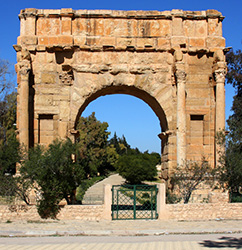
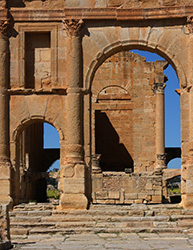
Sbeitla, Tunisia - 2nd Century AD Sbeitla, Tunisia
Architecture
The Roman Arch


Sbeitla, Tunisia
- 2nd Century AD
Sbeitla, Tunisia
Why is it called the Roman Arch?
Examples of the arch are found in other cultures, ones even older than Roman. For instance, there are examples of the Greeks and the Egyptians using arches in their constructions. It's the Roman Arch because the Romans took the simple arch and made it the center point, the mark of identification, for a Roman building. They made it grand, beautiful and structurally strong.
The Roman Arch allows for larger building because it can replace solid building materials with open space.
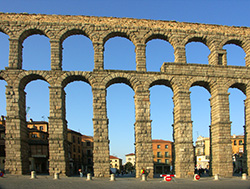
Aqueduct - Segovia, Spain - Circa 100 AD
The arch allows for lighter buildings with more open wall space to allow for more light to enter the building.
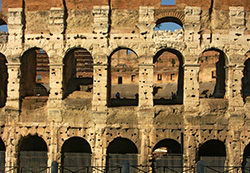
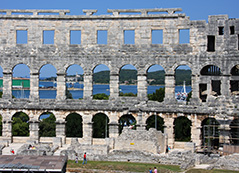
Roman Amphitheater (Colosseum)
Roman Amphitheater - Pula, Croatia
Rome, Italy Circa
80 AD
Pula, Croatia - Circa 90 AD
How does it stand up?
Why doesn't it fall down?
A Way Overly-Simplified Analysis of a Nine Block Arch

The arch depicted is made up of nine arch block placed in a semicircle, along with a left and right base. The interfaces between blocks, and between blocks and base, are numbered 0 through 9.
In this simple example, the inner and outer radii are given as 7 and 9 feet, respectively. The thickness is given as 2 feet.
The force fC represents the compression force acting on the block to the clockwise right. Force fF represents the friction force acting on the clockwise block right.
The results of the analysis are given below.
block span = 20 degrees
block mass center radius = 8.0
block area = 4 sq ft
block volume = 11.17 cu feet
block weight = 1809.6 pounds
Block Compression
Friction Max Friction Safety
Interface Force
Force Force
Difference
0
8143.0 1196.6
3501.5 2304.9
1
6360.7 1041.8
2735.1 1693.3
2
4793.4 1325.3
2061.2
735.9
3
3630.1 1038.4
1561.0
522.6
4
3011.2
387.8 1294.8
907.0
5
3011.2
-387.8 1294.8
907.0
6
3630.1 -1038.4
1561.0
522.6
7
4793.4 -1325.3
2061.2 735.9
8
6360.7 -1041.8
2735.1 1693.3
9
8143.0 -1196.6
3501.5
2304.9
Max Friction is the product of the compression force times the granite's coefficient of friction. The Safety figure indicates the margin between the maximum friction and the computed frictional component - the larger the positive number the better.